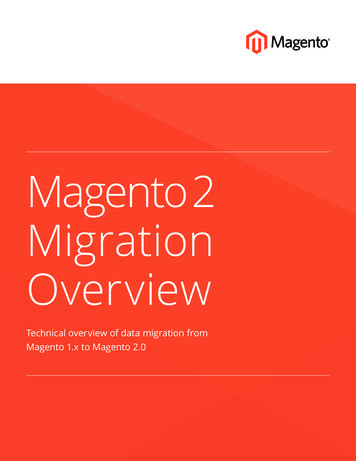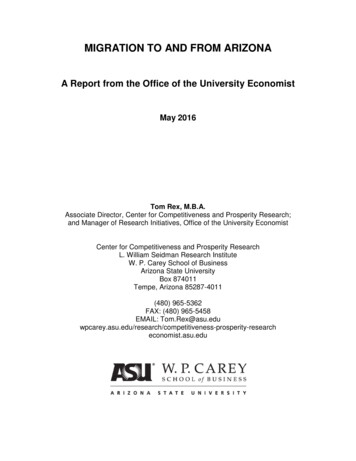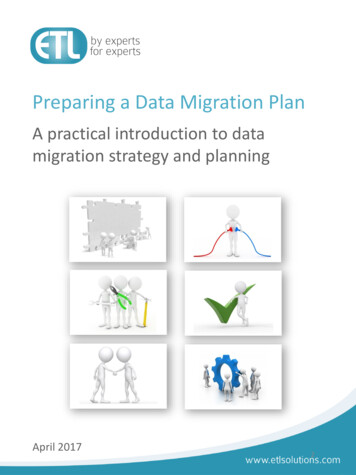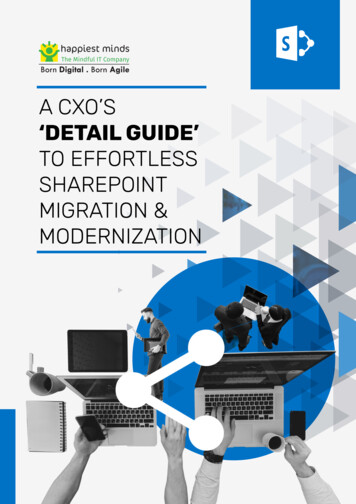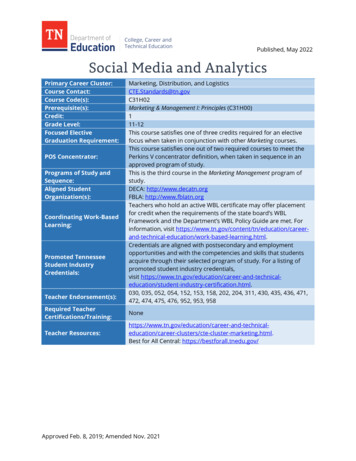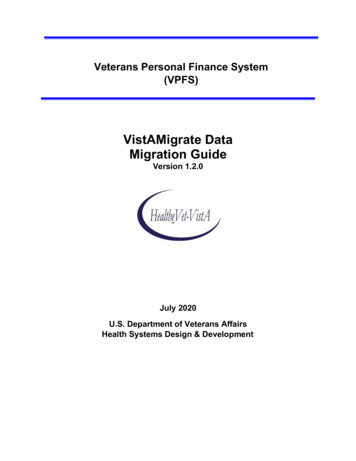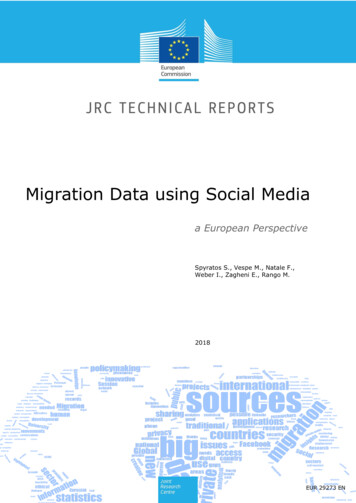
Transcription
Migration Data using Social Mediaa European PerspectiveSpyratos S., Vespe M., Natale F.,Weber I., Zagheni E., Rango M.2018EUR 29273 EN
This publication is a Technical report by the Joint Research Centre (JRC), the European Commission’s scienceand knowledge service. It aims to provide evidence-based scientific support to the European policymakingprocess. The scientific output expressed does not imply a policy position of the European Commission. Neitherthe European Commission nor any person acting on behalf of the Commission is responsible for the use thatmight be made of this publication.Contact informationName: Spyridon SpyratosAddress: TP 266, Via E.Fermi 2749, 21027 Ispra (VA), ItalyEmail: spyridon.spyratos@ec.europa.euTel.: 39 033278 5024JRC Science Hubhttps://ec.europa.eu/jrcJRC112310EUR 29273 ENPDFISBN 978-92-79-87989-0ISSN 1831-9424doi:10.2760/964282Luxembourg: Publications Office of the European Union, 2018 European Union, 2018Reuse is authorised provided the source is acknowledged. The reuse policy of European Commission documentsis regulated by Decision 2011/833/EU (OJ L 330, 14.12.2011, p. 39).For any use or reproduction of photos or other material that is not under the EU copyright, permission must besought directly from the copyright holders.Spyratos, S., Vespe, M., Natale, F., Ingmar, W., Zagheni, E. and Rango, M., Migration Data using Social Media:a European Perspective, EUR 29273 EN, Publications Office of the European Union, Luxembourg, 2018, ISBN978-92-79-87989-0, doi:10.2760/964282, JRC112310.All images European Union 2018
ContentsAcknowledgements . 1Abstract . 21 Introduction . 32 Data . 52.1 Facebook Network data . 52.2 Official statistic . 62.2.1 Eurostat migration statistics . 62.2.2 UNDESA population statistics . 73 Methodology . 83.1 Understanding the data bias. 83.2 Data preparation and cleaning . 103.3 Model . 103.3.1 Selection of the weight of the destination country WD . 123.3.2 Estimating lower and upper bounds . 144 Results & Discussion . 165 Conclusions . 21References . 22List of abbreviations and definitions . 24List of figures . 25List of tables . 26Annexes . 27Annex 1. List of countries of previous residence taken into consideration . 27Annex 2. List of countries of destination taken into consideration . 27Annex 3. Three most overestimated and underestimated countries of previousresidence for each country of destination . 28i
AcknowledgementsWe would like to thank Tintori Guido and Pietro Argentieri for their contribution to thisreport.AuthorsSpyratos Spyridon1, Vespe Michele1, Natale Fabrizio1, Weber Ingmar2, Zagheni Emilio3,Rango Marzia41234European Commission, Joint Research Centre, Knowledge Centre on Migration and DemographyQatar Computing Research Institute, Social Computing GroupDepartment of Sociology, University of WashingtonInternational Organization for Migration, Global Migration Data Analysis Centre (GMDAC)1
AbstractMigration is a top political priority for the European Union (EU). Data on internationalmigrant stocks and flows are essential for effective migration management. In this report,we estimated the number of expatriates in 17 EU countries based on the number ofFacebook Network users who are classified by Facebook as “expats”. To this end, weproposed a method for correcting the over- or under-representativeness of FacebookNetwork users compared to countries’ actual population. This method uses Facebookpenetration rates by age group and gender in the country of previous residence and countryof destination of a Facebook expat. The purpose of Facebook Network expat estimations isnot to reproduce migration statistics, but rather to generate separate estimates ofexpatriates, since migration statistics and Facebook Network expats estimates do notmeasure the same quantities of interest. Estimates of social media application users whoare classified as expats can be a timely, low-cost, and almost globally available source ofinformation for estimating stocks of international migrants. Our methodology allowed forthe timely capture of the increase of Venezuelan migrants in Spain. However, there areimportant methodological and data integrity issues with using social media data sourcesfor studying migration-related phenomena. For example, our methodology led us tosignificantly overestimate the number of expats from Philippines in Spain and in Italy andthere is no evidence that this overestimation may be valid. While research on the use ofbig data sources for migration is in its infancy, and the diffusion of internet technologies inless developed countries is still limited, the use of big data sources can unveil usefulinsights on quantitative and qualitative characteristics of migration.2
1 IntroductionMigration is a top political priority for the European Union (EU). To address this, in May2015 the European Commission (EC) introduced the European Agenda on Migration(European Commission 2018), highlighting explicitly the need for more and better use ofinformation for several policy areas. Data on international migrant stocks and flows areessential for effective migration management, including the design, implementation andevaluation of policies. Improving data and their disaggregation by basic characteristics,among which migratory status, is also an overarching requirement of the 2030 Agenda forSustainable Development, and part of the first objective of the Global Compact for Safe,Orderly and Regular Migration currently under negotiation.Statistics on international migrant stocks are available from the United Nations’Department of Economic and Social Affairs (UNDESA), the World Bank, Eurostat (for EEAcountries), and the Organization for Economic Co-operation and Development (OECD; forOECD countries). These statistics are characterized by a number of limitations and gaps,which reflect the limited availability of up-to-date and comprehensive statistics oninternational migrant stocks at the national level, particularly in low-income countries.Since international migrant stock data mainly derive from national population censuses,which are conducted infrequently in most countries, they hardly capture the age-sexdistribution of international migrants in a country in a timely fashion. Second, thesestatistics are based on data provided by individual countries with separate collectionsystems and designs (Raymer et al. 2013). Third, they fail to describe new and transientforms of migration, such as transnationalism or circular migration, and often only give apicture of regular migration, since irregular migrants might not appear in censuses orofficial registers. For instance, as observed by Sinn, Kreienbrink and Von Loeffelholz(2005), in Germany even a thorough analysis of available data sources cannot providereliable data on the size and composition of the irregular resident population. There are noofficial datasets on irregular migration and irregular migrants in the EU (Vespe, Natale andPappalardo, 2017), although several existing datasets can be used as proxies to provideestimates. The lack of data on irregular migration is a matter of serious concern amongscholars and the international community (Vono De Vilhena, 2018).Innovative sources offer data that are timely, have a wide coverage, can be accessible atlimited cost, and can potentially include information that may not always be provided bytraditional migration data sources. As of April 2018, the Facebook Network (i.e. Facebook,Instagram, Messenger and the Audience Network) reported more than 2.15 billion monthlyactive users5. The digital traces that Internet users are actively or passively generating canpotentially be exploited for studying migration-related phenomena. In 2014, the UnitedNations (UN) recognized the importance of big data for official statistics, and established aGlobal Working Group on this topic (UN 2018). The potential of new data sources (e.g.Facebook) to provide policy-relevant information on international migration is currentlybeing explored by international bodies and initiatives such as the Big Data for MigrationAlliance (BD4M), recently launched by the European Commission Knowledge Centre onMigration and Demography (KCMD) and IOM’s Global Migration Data Analysis Centre(GMDAC), following a dedicated workshop on the topic (Rango and Vespe 2017).However, social media users are not representative of the society at large as they areprone to a selection bias. People with different age, sex, socioeconomic and culturalbackgrounds use social media applications to varying degrees (Smith and Anderson 2018).Apart from issues of representativeness, the use of personal data from social mediaapplications raises concerns regarding the disclosure of personal information, as well asthe integrity and the overall governance of the data by the entity that collects them. Forexample, the recent Facebook and Cambridge Analytica data breach scandal sparkedsignificant public discussions about the lack of ethical and privacy standards in social mediacompanies. The inherent bias of social media data described above, coupled with the riskof a lack of control on how the data are derived and processed cause /marketing-apis3
regarding the possibility of effectively using such data for demographic research. Thisrequires the development of appropriate methods for quantifying and mitigating such biasas well as the active collaboration with the social media companies themselves. Moreover,an in-depth evaluation of the potential of these data sources is needed to respond reliablyto societal challenges and policy questions related to migration.Several studies have used big data sources, such as social media and internet services, foranalysing migration-related phenomena. Seminal work in this area was carried out byZagheni, Weber and Gummadi (2017), who used data from Facebook’s advertisingplatform to estimate the stock of international migrants in the US. Messias, Benevenuto,Weber and Zagheni, (2016) used Google data for studying location patterns of migrantswho have lived in more than two countries. State, Ingmar and Zagheni (2013) and Zagheniand Weber (2012) estimated global flows of migrants and tourists using the IP geolocationof over 100 million anonymized users of Yahoo! Web services and of a large sample ofYahoo! Email messages sent between September 2009 and June 2011. Zagheni, Garimella,Weber and State (2014) and Hawelka et al. (2014) analysed trends in mobility andmigration flows using geo-located ‘tweets’. Ahas, Silm and Tiru (2017) used roaming datafrom mobile operators to map transnationalism from Estonia. Dubois, Zagheni, Garimellaand Weber (2018) used data from Facebook’s advertising platform to estimate the levelsof assimilation of Arabic-speaking migrants in Germany. Herdagdelen, State, Adamic andMason (2016), from the Facebook data science team, studied the composition ofimmigrants’ social networks in the United States (US) using the structure of their friendshipties. Finally, State, Rodriguez, Helbing and Zagheni (2014) and Barslund and Busse (2016)investigated mobility patterns of highly skilled migrants using data from LinkedIn. A recentreport prepared for the European Commission investigated the feasibility of using big datafor studying migration issues (European Commission et al. 2016) and concluded that bigdata sources a) do not substitute traditional data sources but they can complement them;and b) can be used for estimating trends or changes in trends in migration flows in a timelymanner.Our research is based on the work of Zagheni, Weber and Gummadi (2017), and isinnovative since it proposes a new method which takes into account the difference betweenthe definition of “expat” as used by Facebook and the statistical definition of a foreign-bornmigrant as per the 1998 UN Recommendations on Statistics of International Migration 6.The aim of the proposed method is to create independent estimates of Facebook Network“expats” instead of trying match the Facebook Network-provided expat estimations toexisting official migration data in absolute terms. To this end, the proposed methodcalibrates the number of Facebook Network expats by using the penetration rate ofFacebook Network in the country of destination and in the country of previous residenceof migrants. To estimate the penetration rate of Facebook Network usage in a country weuse population data. The proposed method uses migration data only to identify the degreeto which a migrant assimilates to the Facebook Network usage patterns of the destinationcountry.The rest of the article is structured as follows. The next section describes the officialpopulation and migration data and the Facebook Network data used in this research. Wethen explain the methodology used to estimate the number of individuals who fulfil specificdemographic criteria (e.g. “Italian expats in Germany”), based on Facebook Networkstatistics. The Results & Discussion section presents validated figures of the proposedmodel in Europe. Conclusions are outlined in the final eriesM/SeriesM 58rev1e.pdf4
2 DataIn this study, we use both traditional data available from Eurostat and UNDESA, and datafrom an innovative source – the Facebook advertising platform. The following sectionsdescribe the data in more detail.2.1 Facebook Network dataWe use data from the Facebook advertising platform 7 to estimate stocks of “expats” invarious countries (see below for a discussion on the definition of “expat”). The Facebookadvertising platform allows advertisers to select the characteristics of their target audience,for instance, age and gender, and to obtain an estimate of the number of monthly activeusers of the Facebook Network (Facebook 8, Instagram9, Messenger10 and the AudienceNetwork11) who meet the selected criteria and could be reached through an advertisingcampaign. According to Facebook, this estimation is a unique calculation based on factorssuch as user self-reported demographic characteristics, and is not intended to align withthird-party calculations or population census data. The frequent discrepancy betweenFacebook Network estimations of the number of individuals with certain characteristicsliving in a country and census data on the same population groups opens up questionsabout the reliability of Facebook estimates on the one hand, and the possible gaps intraditional statistics, on the other.Through the Facebook’s Marketing Application Programming Interface (API) 12, we collecteddata about the number of monthly active users of the Facebook Network based on thecountry of their current location, their age, gender and the country of their previousresidence of which they are considered as expats. For example, we queried the number ofFacebook Network users who now live in France, are male aged between 20 and 24 yearsold and are classified by Facebook as expats from Italy. As of February 2018, Facebookprovided estimates about the expats of 89 countries. Facebook Network data for the EUcase-study countries were collected between 30 January 2018 and 5 February 2018.Facebook does not provide the exact number of users that match specific criteria but givesa rounded number. As of 26 February 2018, the minimum response of Facebook marketingAPI to queries regarding its monthly active users was increased from 20 users to 1000.This means that one would not be able to obtain the number of monthly active users whomatch specific criteria unless the total number of users in this group is higher than 1000The Facebook Network’s definition of expats – “People who used to live in country X whonow live abroad” – is quite generic. Facebook does not disclose details about the methodused for classifying users as expats. A study by Facebook staff Herdagdelen et al. (2016)categorized Facebook users as expats based on their “hometown,” as reported in theirprofiles. However, it is unclear whether the Herdagdelen et al (2016) approach is currentlyused by Facebook. We therefore conducted an online survey to understand how Facebookclassifies its users as expats. The survey was limited to Facebook users and excluded usersof other Facebook Network applications (Instagram, Messenger and Audience Network).As part of the survey, a) we requested participants to provide us with some personalinformation, i.e. country of origin/home country and current country of residence, b) to tellus what information they are reporting on Facebook, i.e. current city and hometown, andfinally c) to access the “Ads preferences” Facebook webpage13 and check whether Facebookclassifies them as expats. A total of 114 Facebook users participated in this small survey,of whom 27 were not able to visualize any Facebook categories in the “Ads preferences”webpage. Of the remaining 87 participants, 62 were expatriates (living in a country om/ads/preferences785
than their country of their hometown). Figure 1 shows how Facebook classified these 62participants.Figure 1. Facebook classification of users who are expatriates (total: 62).Expats of their home country91Expats all category - notspecifying country314Expats of the country of previousresidence35Expats of both home country andcountry of previous residenceNot ExpatsOf the 35 Facebook users who were classified by Facebook as expats of their home country(56% of the total), 14 stated that they did not report their hometown on their Facebookprofile. Despite the small sample, this analysis suggests that Facebook uses additionalattributes for estimating the country of an expat, in addition to user self-reportedinformation on their home country. 14 participants were classified as expats but without aspecification of the country (“Expats all category”); the 8 out of these 14 participants areoriginated from countries for which Facebook does not currently provide expat estimates,i.e. Bulgaria and Turkey. This simple survey was useful to understand how Facebookclassifies expats but cannot be used for quantifying the accuracy of such a categorization,because of two main methodological limitations. First, our sample is not random, sincemost of the participants belong to the social and professional network of the authors ofthis study. Second, during a validation exercise that we conducted by contacting someparticipants, we realized that a proportion of those who are expatriates and declared thatthey are not classified by Facebook as expats, responded inaccurately. This is because theywere not navigating correctly to the “Ads preferences” Facebook webpage where thecategories (e.g. “Italian expat”) were listed. To conclude, Facebook uses the “country ofhome town” and/or “country of previous residence” Facebook attributes for classifying itsusers as expats, among other attributes like geo-referenced information.2.2 Official statisticOfficial statistics on international migrant stocks disaggregated by age, sex, country ofbirth and destination were used to a) identify the degree to which a migrant assimilates tothe Facebook Network usage patterns of the destination country and b) evaluate andcompare the results of the model proposed. Migration statistics at this level ofdisaggregation are available from UNDESA (2008), the OECD in collaboration with theWorld Bank (2010) and Eurostat (2017a). We used Eurostat statistics since they were moreupdated. We additionally used updated population statistics from UNDESA (2017a) forcalibrating the Facebook Network data.2.2.1 Eurostat migration statisticsStatistics from Eurostat were used as a reference since they are more recent compared tostatistics from the other two sources. Eurostat provides statistics disaggregated by countryof birth and citizenship. The survey we performed suggested that Facebook mainly usesinformation on the country of the user’s hometown and, secondarily, country of previousresidence for defining a user as an expat of a country. Since the country of a user’shometown does not necessarily coincide to the country of birth or the country citizenship,6
in this study we assume that the country where the hometown is located mostly refers tothe country of birth. Thus, we selected the Eurostat dataset that provides disaggregationby country of birth, entitled “Population on 1 January by age group, sex and country ofbirth” (Eurostat 2017a), and it is hereafter called “Eurostat foreign-born migrant dataset”.Eurostat adopts the UN definition of a (long-term) international migrant as a person whochanges his or her place of usual residence for a period of at least 12 months (includingpeople who arrive in a country with the intention of staying for at least 12 months) 14,15.Eurostat provides figures of international migrant stocks for the reference year 2017, byage group, sex and country of birth for 18 EU countries.16 It is worth mentioning that thesecountries do not include three major EU countries – Germany, France and the UnitedKingdom.2.2.2 UNDESA population statisticsUNDESA population statistics are used in the study as an input in our model, to calibrateFacebook Network statistics. Using UNDESA population statistics, we estimated thepenetration rates of the Facebook Network in each country, by age group and gender.UNDESA statistics are available for 200 countries globally, and are disaggregated by sexand 5-year age groups (UN/DESA 2017a).17 We used population estimates (mediumprojection variant) for the year 2018, to match temporally the Facebook Network on/SeriesM/SeriesM data/en/demo pop esms.htmThese countries are Austria, Belgium, Bulgaria, Czech Republic, Denmark, Estonia, Spain, Finland, Hungary,Italy, Lithuania, Luxembourg, Latvia, Netherlands, Romania, Sweden, Slovenia and Slovakia.The dataset used is “Population by 5-year age groups, annually from 1950 to 2100”7
3 MethodologyWe developed a methodology to estimate the number of individuals who fulfil specificdemographic criteria based on non-representative Facebook Network statistics. Forexample, we want to estimate the number of individuals who are in a particular age group,are female or male, who used to live in, e.g. Germany, and who now live in another country,e.g. France, based on the number of Facebook Network users that meet those age andgender criteria and are classified by Facebook as German expats in France. In the followingsections, we first analyse the Facebook Network data and its limitations, then we preassess and clean the Facebook Network statistics, and lastly, we present the model thatwe developed.3.1 Understanding the data biasWe analysed the characteristics of Facebook Network statistics to develop a robust modelfor correcting the bias given by the fact that Facebook Network users may over or underrepresent a country’s population at large. As shown in Figure 2, Facebook Network users’representativeness varies based on the country under consideration, as well asdemographic characteristics of the population, namely gender and age. In Morocco, use ofFacebook Network platforms is more widespread among males than females, while in Italythe differential in usage patterns based on gender is very small. When the number ofFacebook Network users in a country and a given age group is higher than the actualnumber of residents in that age group (based on official statistics), it means that usershave multiple unlinked Facebook Network accounts, for instance on Facebook, Instagramand Messenger. We assume that there are two main drivers of Facebook Networkplatforms’ usage. The first is users’ socio-psychological altitude towards Facebook Networkplatforms18. Second, there are technological and artificial constraints, for example, lowinternet penetration and restricted access to Facebook Network platforms in somecountries. As shown in Figure 3 the percentage of individuals using the internet(International Telecommunication Union 2016a) explains 51% of the total variation in theFacebook Network penetration rates.Figure 2. UNDESA population and Facebook Network (FN) users in Morocco and Italy by age andgender. Light shading UNDESA population, mid shading UNDESA & raw FN users, and dark shading raw FN users18For a detailed analysis of social media research theories we direct the interested reader to Ngai, Tao and Moon(2015).8
Figure 3. Internet penetration rates Vs Facebook Network penetration rates across countries.The popularity of different Facebook platforms also varies across countries due to theexistence of alternative platforms -- for example, the most popular social networking sitein Russia is not Facebook but VKontakte. Usage patterns of Facebook Network platformsby gender vary considerably across countries. A study by Fatehkia, Kashyap and Weber(2018) demonstrated the feasibility of using Facebook data for quantifying digital gendergaps. In our study, we demonstrate the correspondence between the Gender DevelopmentIndex (GDI) and gender inequalities in the usage of Facebook Network applications. TheGDI measures gender inequalities in three basic dimensions of human development: longand healthy life, education, and command over economic resources (United NationsDevelopment Programme 2016). As shown on the left side of Figure 4 the GDI and genderinequalities in penetration rates of the Facebook Network across countries are correlated(R2 0.67, p 0.001). The GDI is also correlated with gender inequalities in internet accessavailable from the International Telecommunication Union (2016b) (R2 0.49, p 0.001)(Figure 4). Interestingly, the GDI correlates to a higher degree with inequalities inpenetration rates of Facebook Network platforms than with internet penetration rates.Financial, educational and cultural barriers in countries with conservative gender normsmay prevent women from using social media (Fatehkia, Kashyap, and Weber 2018).Figure 4. Correlation between the Gender Development Index (GDI) and female/male FacebookNetwork penetration rates (on the left side of the figure) and correlation between the GDI andfemale/male internet penetration rates across countries (on the right side of the figure).9
3.2 Data preparation and cleaningIn the data preparation phase, we pre-assessed and cleaned the Facebook Networkstatistics. We evaluated Facebook Network data and we excluded from our analysiscountries of previous residence and countries of destination for which either FacebookNetwork data were not reliable, or the use of Facebook was not permitted, or for which nothird-party data were available. More specifically: Expats from the US and Greece. It appeared that the Facebook advertising platform isunderestimating the number of Greek expats and overestimating the number ofAmerican expats. As of April 2018, the number of Facebook Network users, aged 15—64 years old, who are classified as Greek expats worldwide is 10,000, far lower thanthe official UNDESA (2017b) estimate of international migrants born in Greece andresiding abroad in 2017, equal to 993,000. In the case of the US, there are 443,500US expats Facebook Network users aged 15—64 residing in Italy, while US-bornmigrants residing in the country and within the same age group are only 40,073, basedon Eurostat statistics. Expats from China. Access to Facebook is not possible in China19, and since theproposed method requires knowledge of the Facebook Network penetration rate in thecountry of previous residence, we excluded Chinese expats from our analysis. Expats from Cuba, Puerto Rico, Hong Kong and Monaco. Expats from Cuba wereexcluded from the analysis since no Facebook Network statistics were available for thiscountry. Expats from Puerto Rico and Hong Kong were excluded for lack of availab
Zagheni, Weber and Gummadi (2017), who used data from Facebook's advertising platform to estimate the stock of international migrants in the US. Messias, Benevenuto, Weber and Zagheni, (2016) used Google data for studying location patterns of migrants who have lived in more than two countries. State, Ingmar and Zagheni (2013) and Zagheni


